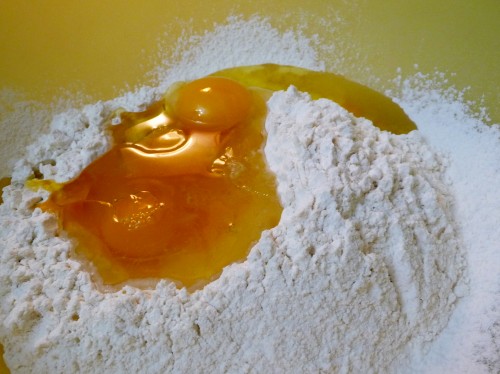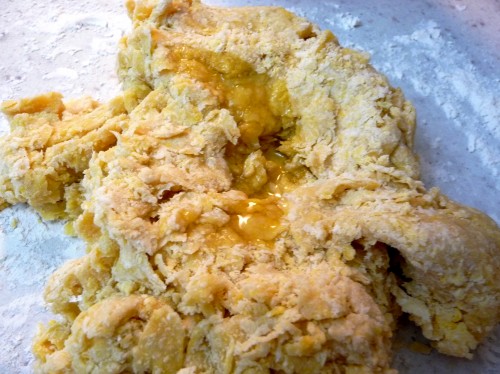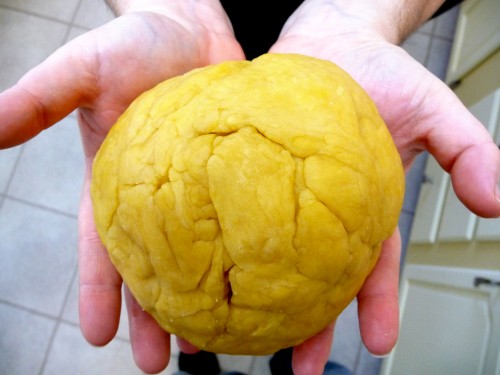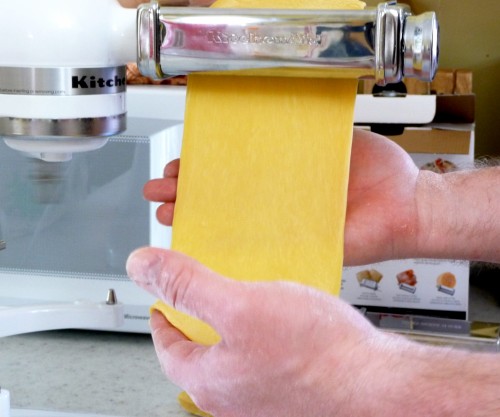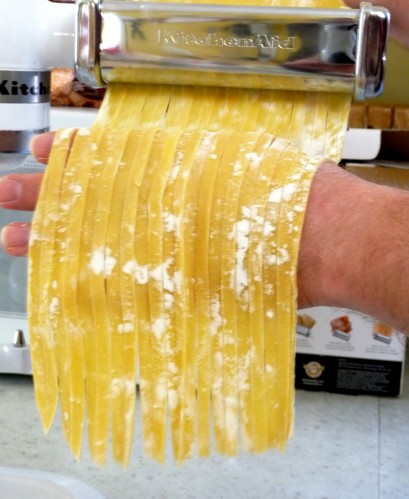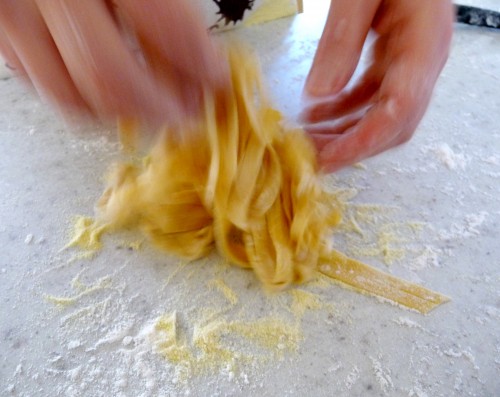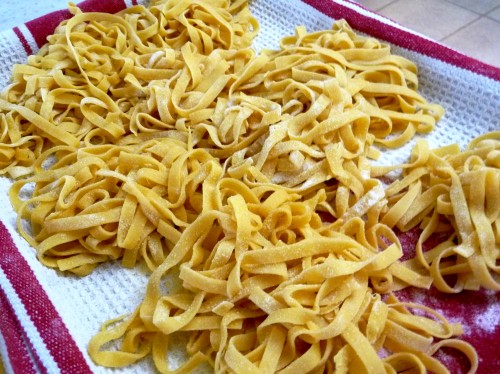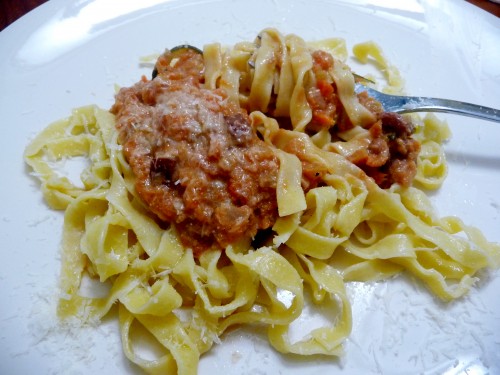I have prepared and shared a plethora of Italian pasta dishes in the last three-plus-years on this site. I have experimented with homemade gnocchi and gnudi before- but one thing that has alluded me was making fresh homemade pasta.
Perhaps because of the time needed. Perhaps because of the equipment required. Or perhaps I was just afraid. Very afraid.
That all changed last Sunday, as I dove in to make my first attempt at fresh homemade pasta at a friend’s house.
First let me say, there are many different types of pastas, recipes, methods and types of equipment. I used a variation of an egg pasta dough recipe from Lidia Bastianich which has been adjusted at my friend’s recommendation. I also was lucky enough to make use of a Kitchen Aide stand mixer and pasta attachments.
1. Making the homemade pasta dough
sift 1 cup of all-purpose-flour into a bowl or on your countertop {I used King Arthur flour}
form a well in the center
put 3 eggs and 1 egg yolk into the well
add 3 tablespoons of olive oil
add 2 tablespoons of water
Using a wooden spoon, incorporate flour closest to the center of the well and continue moving outward. When the dough starts to come together, forgo the spoon and dive in with your hands. If the dough is dry try adding a teeny bit of olive oil to moisten it.
Kneed the dough, but don’t overwork it. Once it forms, shape it into a ball. Your finished dough will look like this:
Now, wrap this in plastic and let it sit for about 30 minutes.
Meanwhile, set up your pasta making station:
You’ll need –
~ a large workspace, dusted with all-purpose-flour
~ a few baking sheets lined with clean dishtowels
~ a Kitchen-Aide stand mixer with pasta attachments or a hand crank pasta roller.
2. Making the Pasta Sheets
Set up the Kitchen-Aide stand mixer with the pasta attachment which rolls the dough into flat sheets. Set the dial to thickness #1 and turn it on.
Unwrap the ball of dough, flatten slightly and cut the dough into six equal triangles, like you are cutting pizza slices.
Take one triangle, flatten slightly with the heel of your hand and feed one corner through the rollers.
Let the pasta sheet come through, gently supporting each end so that the dough feeds through smoothly – be careful not to pull it.
Repeat this process another 4 times with that sheet, each time adjusting the rollers to positions 2, 3, 4 and finally 5.
Place the finished sheet on top of the flour dusted workspace. Trim the pointed edges off of each end. If your sheet is very long, cut it in half as it will be easier to work with later. Flip pasta sheet over a few times until lightly covered in flour on each side. This is to help dry the pasta out and to prevent sheets from sticking together.
Repeat the process with the remaining five pieces of dough, until all of the dough is now drying in sheets.
At this point, you can decide what shape of pasta you would like. Prepared sheets can be used as-is for ravioli, lasagna or other types of pasta.
We chose to make fettuccine, which required further cutting.
3. Making the noodles
Switch out the pasta attachment for the one that makes fettuccine and turn it on.
Using the same motion as before, guide the pasta sheets through the attachment, being careful to feed it through straight and to keep your fingers away from the inner mechanism.
Let the cut noodles fall to the counter, scoop them up, toss them in some semolina flour until lightly coated and place each pile on top of the towel-covered baking sheet to dry further.
Repeat this process with the remainder of the sheets until all the noodles are cut.
Leave the pasta in nests to dry for a bit before cooking or freezing. Freeze pasta in tupperware or refrigerate if you plan to use it within a few days.
4. Cooking the Pasta
Fresh pasta cooks very quickly. Much faster than dried pasta. I’d recommend preparing your sauce first. Have it done and ready to go, and throw the fresh pasta into boiling water at the last moment. Cook the pasta, until al dente, just 2-3 minutes and add it right to the sauce.
We had prepared a simple, yet delicious sauce using a base of soffritto with canned San Marzano tomatoes, pancetta, red wine and herb ricotta.
The results were rich and flavorful. Just look at those gorgeous fettuccine noodles!
5. A Few Quick Notes
~ The more you make homemade pasta, the better you will become at adjusting for things like the dough’s consistency, the humidity and how fast you need to work to avoid the dough from drying out.
~ You dough will probably come out differently every time you make it.
~ Though making dough by hand was fun, next time I will try to utilize modern technology and use the food processor or Kitchen-Aide mixer to prepare it. I’ll leave the completely-by-hand-dough-making to the real Italian Mammas.
While making my own pasta was time consuming, it was also fun and rewarding. The flavor was better and the consistancy was decidedly different from dried pasta. It certainly wasn’t as daunting as I feared. I don’t know how often I’ll opt to make my own, but this definitely won’t be my only attempt.
I think I see some ravioli in my future. Whose coming to dinner?
Now, it’s your turn to share! Have you ever made your own pasta? What kind did you make?
What was the result? Would you do it again?

